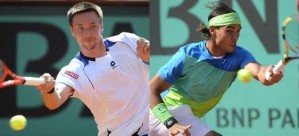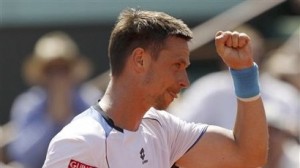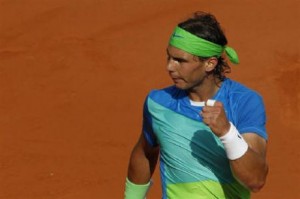2010 French Open Final: Can Soderling Beat Nadal Again?
In the absence of yet another clash between Roger Federer and Rafael Nadal, the best Roland Garros final we could probably have asked for was this one, as Nadal seeks to overcome the only man to have ever beaten him on French clay.
That man, Robin Soderling, has added to his number of high-profile wins, but on Sunday seeks to become more than just an answer to a trivia question.
Robin Soderling
Last year the big Swede Soderling played the role of Ivan Drago or, for the more realistic, George Foreman, the heavyweight whose sheer puissance overwhelmed all obstacles, including his own lack of variety.
Sure, Nadal wasn’t at the top of his game, but a lot of that had to do with Soderling not allowing him to play his best. The Swedish clubber crushed so many forehands, drove so many two-handed backhands up the line and serve so huge that all the best clay court defender of our day could do was try to hang on.
He failed, and so would Nikolay Davydenko in the next round, as Soderling allowed him just five games. The mystique of Soderling as the hugest hitter, a force that could not be resisted and combined with a ruthless persona that even Nadal couldn’t warm to, lasted all the way to the finals.
There he met Federer, who could deflect Soderling’s pace and quickly turned the match into a contest of serving placement, volleying touch and drop shots. Suddenly, Soderling looked about as awe-inspiring as a heavyweight boxer trying to ice skate for the first time. What’s more, his image as a brute was permanently punctured when he said, in the trophy presentation, that Federer had given him a lesson on “how to play tennis.”
In the year since then Soderling has put up good results, somewhat unlucky to have faced Federer in the last three of 2009’s majors, but lacked any major statements following his defeat of Nadal.
Which made his win over Federer in the quarters of this year’s RG all the more astounding. When it began, Federer was his usual brilliant self, blocking back Soderling’s serve, forcing him to struggle to hold serve and then winning his own serve games almost at will. The Great Swiss only lost two service points in the whole first set.
But this time the Swede did not crumble, and he held his serve all but one time in set one. Though he lost it, this kept his confidence up and bought him time before the rains came. In damp, wet conditions, Federer had a lot more trouble returning the Swede’s pace and placing the ball as immaculately as usual.
The new, improved Soderling overpowered the Swiss and then, at the end, showed that his personality retains its dark edges, as the cameras captured him clenching his fist and glaring ahead in a manner that could frighten a grizzly.
After outlasting fellow heavyweight Tomas Berdych in the semis, Soderling now looks to go one round better than last year. To do so, he needs only to beat Nadal a second time.
Rafael Nadal
Going into last year’s RG, the Majorcan Mauler had never lost in Paris, was defending both Wimbledon and Australian crowns, and had captured Monte Carlo and Rome for the fifth and fourth occasions.
His defeat at the hands of Soderling last June was the most jarring jolt the men’s game has seen in decades, maybe ever. That, combined with the damage the tour has inflicted on his knees, drove him from the game until August and from the winner’s circle for nearly a year.
After putting forth a solid spring in which he didn’t quite breakthrough at the Masters events of Miami and Indian Wells, Nadal finally resumed his dominance of the dirt at Monte Carlo, becoming the first man to win any event six times in a row. Having won in Rome, then topped Federer in Madrid, he is now the first man to win all three clay court Masters Shields in the same year.
After the struggles of the past year, his play at this year’s Roland Garros has reflected his newfound commitment to his physical well-being, as he has plowed through his draw without dropping a set. This is mostly testament to his experience, his speed, and of course the spin of his forehand.
It’s the third time he has reached the RG final without dropping a set, but does not feel as dominant as his previous romps in 2007 and 2008, when very tough opponents like Carlos Moya and Fernando Verdasco were struggling to win games. Some of that is Nadal’s new commitment to knee preservation, as he has hit more aggressively, making more errors and not running down every ball.
Some of it, though, may be nerves. A miserable game on Friday against Jurgen Melzer when serving for the match allowed the Austrian a chance to push the Spaniard to a third-set tiebreak. Occasional spotty play allowed Lleyton Hewitt, Thomas Bellucci and Nicolas Almagro to stay close, when the ’07 and ’08 Nadal would have simply pulled away.
After more than a year without tasting Grand Slam glory and with more and more questions about his knees, Nadal knows that this event is a turning point in his career. If he wins it, he joins Mats Wilander and John McEnroe with seven majors, comes one RG within Bjorn Borg’s record of six, and, as improbable as it seemed in January, becomes No. 1 again.
With a win, he becomes a favorite a Wimbledon. With a loss, it’s hard to say; he’s never entered London having lost in Paris.
The Matchup
Past results are little indication of what to expect here; just a month before their historic encounter last year Nadal crushed Soderling in Rome, 6-1, 6-0. Months after that meeting, Sodering beat Nadal in straights at the world tour finals, then Nadal returned the favor at the exhibition in Abu Dhabi.
None of those situations is really congruent with this one. Soderling wants the major that escaped him this year, and Nadal wants his crown back. Nadal is the fiercest competitor of this era; Soderling is the only man to know what it feels like to beat him down on Parisian clay.
Ultimately, a pair of shots are key; Soderling’s got bigger first and second serves (the difference between him and Berdych in set five) and Nadal moves better. Nadal will need a high percentage of first serves to guard his weak second, and he must defend well. If he, like Federer last year, shows that he can absorb Soderling’s blows and return them, he wins.
If not, Soderling hits him off the court. I suspect that, in the last year, Nadal has been waiting for a situation just like this.
My pick
Nadal wins in four tight sets.



Looks like Soderling is going down in straights – darn! I expected more from the Swede than this showing!! Nadal wanted this one – bad!!
Character game is a single from the application you’ll be able to play in your facebook account and fans of character are hooked up to it.